Zhong Kui was a folk god,a decent honorable chap good for guarding doors and hunting ghosts; a deformed or ugly figure, given to standing fiercely on one leg, known to suck the eyes out of a demon, so popular he gradually worked his way into the formal pantheon….
“The God of Wealth in His Civil Aspect” once belonged appropriately, to the late John D. Rockefeller, Jr., who bequethed it to the Metropolitan Museum of Art. Along with a companion piece of fiercer mien, “The God of Wealth in His Military Aspect,” it is an outstanding example of Chinese porcelain of the K’ang Hsi period ( 1662-1722) . The 23-inch figurines are in five colors of enamel, the throne and crown are gilded silver, and the holes are for inserting a beard of human hair. Their exact identity has always remained a bit elusive and ambiguous, but they may hold important clues in America’s contentious trade relations with China ….

"Passed over for a vile but commonplace prejudice – he was ugly – and driven to suicidal despair, he re-emerges in death’s dark realm as a fabulous kind of thug – a huge, hairy, muscley, ferocious butcher of demons and hunter of ghosts. Buffy, eat your heart out."
The ancient God of Wealth and Riches and could ride a black tiger and hurl pearls that burst like bombshells.Talk about a teen idol.He was the ticket from rickshaw to Rolls-Royce. A gentleman of many strengths and only one flaw: He was susceptible to witches, evil spirits,voodoo, the influence of ghosts and other vagaries of the paranormal. He needed protection. Its a lot on the shoulders of Zhong Kui. Hunting demons with pen and sword.He is a very violent a terrifying writer. Not a sleuth with the most appealing creature features, he is the unseen shadowy figure of whom the fortunes and prosperity of China are perched on his slouched back and dangle from his scraggly mustache; the first line of defense. He was formerly just another tall ghost with a shabby hat who ate devils. The Emperor adored the protection, but wouldn’t give him a promotion because he abhorred his ugly appearance.
…The oriental dragon is usually a beneficent creature which brings rain to the crops; it cannot be compared to the gruesome medieval monster so often portrayed with St. George. The dragon was the emblem of the emperor, just as the feang huang was the symbol of the empress. When they appear together, as on the clothes of the older figure, they are a sign of good omen. …
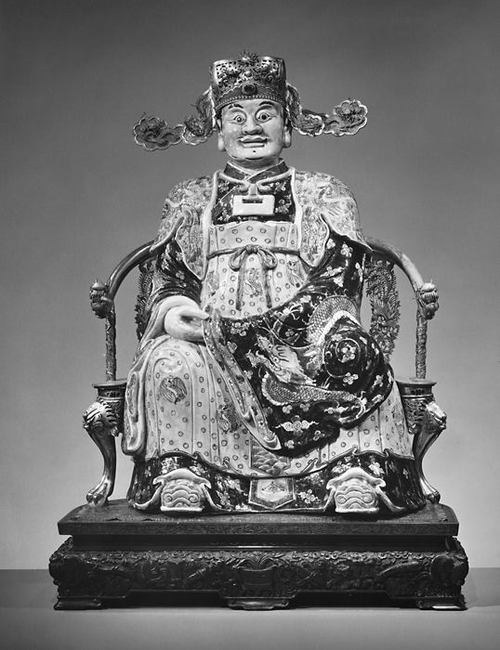
Chow:The united significance of these various symbols makes it clear that our two figures are beings of power and importance, but the very uniqueness of this pair makes it difficult to decide exactly what they were intended to represent. The four-clawed dragons on their robes rule out the possibility that the statues represent emperors, for the "imperial" dragon of the Ch'ing dynasty -used only on the belongings of the emperor himself-always has five claws. Some people identify them as high-ranking officials in the military and civil courts; another opinion is that they are the Taoist gods of affluence and happiness, who together with the god of longevity make up a popular triad known as the "Three- Star Gods."
Who are these figurines working for and how can America use these gods of wealth to right its financial ship? …Sometimes the Chinese artist uses symbolic creatures or plants individually, but more often symbols are combined to enhance the significance of the object decorated, a technique we find in the ornamentation of a pair of K’ang-hsi figurines in the Met that are outstanding among the porcelains in the Rockefeller bequest. No others exactly like them are known. Each figure, seated on a gilded silver throne, represents a man-one grimacing fiercely, the other more youthful and milder in expression. Both are clad in ceremonial regalia and wear elaborate, crownlike official hats “Sha-mao” made of gilded silver filigree adorned with kingfisher feathers, jade, and pearls. In the decoration of their clothing symbols of power and good omen occur repeatedly: the dragon, which ranks highest in thehierarchy of Chinese emblems, appears on the robes of both pieces; the feng huang ,sometimes known as the oriental phoenix, decorates the shoulder cape of the older man; and the crane, a bird second in power only to the feng huang, decorates the overskirts of both.
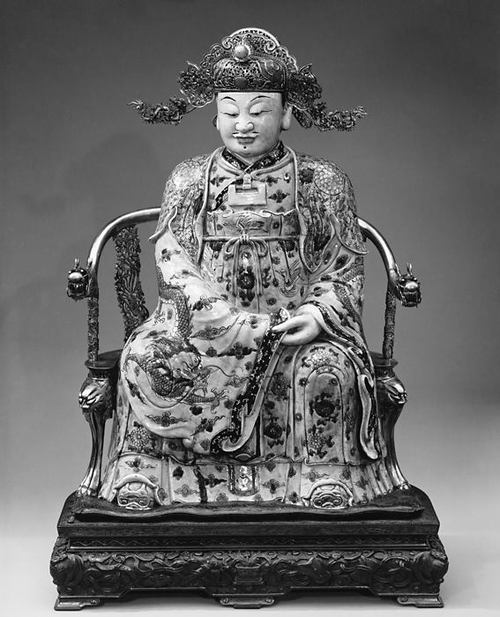
Chow:...Perhaps our statues once held similar emblems, now lost, for there is a space in the hands of both. Without these attributes it is difficult to identify them positively as the gods of wealth. A clue that encourages this interpretation, however, is the Chinese lock that hangs from their necks: this symbol of "locked wealth" may have changed through the ages, but until recent times a miniature gold or silver lock suspended from a child's neck was believed to keep him safe and bring good luck.
The decoration of the figures’ thrones and crowns, on which both the feng huang and the dragon appear, carries further the theme of
power: dragon’s heads occur on the armrests, while the legs of the thrones are made up of a lion’s head and paw. The Chinese did not know much about lions in early times, and it was not until the Han dynasty (206 B.C.-A.D. 220) and later that the winged lion of the Near East and the Buddhist lion of India were introduced into Chinese art as the protectors of sacred buildings and defenders of the law.
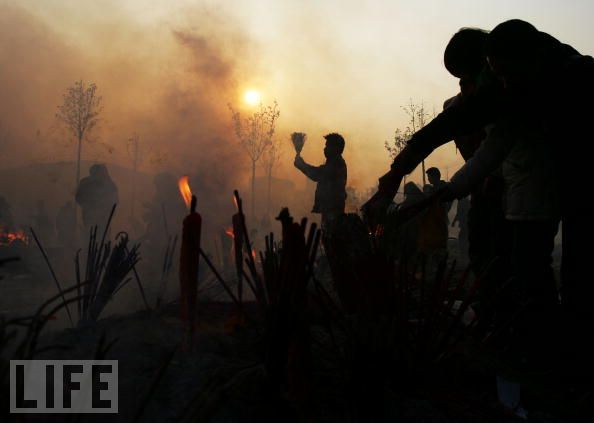
---WUHAN, CHINA - FEBRUARY 11: (CHINA OUT) Pilgrims burn incense to worship the God of Wealth at the Guiyuan Temple on February 11, 2008 in Wuhan of Hubei Province, China. Chinese people have the tradition of worshiping the God of Wealth on the
th day of the lunar new year. Nearly 160,000 people visited the Guiyuan Temple today.---ADDENDUM:
E.T.C WERNER ( 1922 ):When Chiang Tzŭ-ya was fighting for Wu Wang of the Chou dynasty against the last of the Shang emperors, Chao Kung-ming, then a hermit on Mount Ô-mei, took the part of the latter. He performed many wonderful feats. He could ride a black tiger and hurl pearls which burst like bombshells. But he was eventually overcome by the form of witchcraft known in Wales as Ciurp Creadh. Chiang Tzŭ-ya made a straw image of him, wrote his name on it, burned incense and worshipped before it for twenty days, and on the twenty-first shot arrows made of peach-wood into its eyes and heart. At that same moment Kung-ming, then in the enemy’s camp, felt ill and fainted, and uttering a cry gave up the ghost.
Later on Chiang Tzŭ-ya persuaded Yüan-shih T’ien-tsun to release from the Otherworld the spirits of the heroes who had died in battle, and when Chao Kung-ming was led into his presence he praised his bravery, deplored the circumstances of his death, and canonized him as President of the Ministry of Riches and Prosperity.
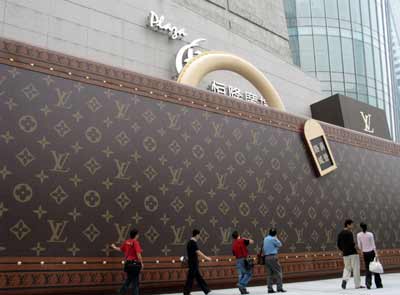
---This attitude among China’s wealthy runs against the prevailing global mood, with struggling consumers are competitive pricing, budgeting their finances, and shopping for value. Luxury brands, however, are experiencing an interesting situation in China, where their global reputation casts only a vague shadow. In lieu of the luxury shopping experience that exposes these breands elsewhere, Chinese buyers are using cost as a yardstick for measuring desirability. To stay competitive, luxury brands in China should actually be hiking prices -- the more outrageous, the better -- to prove they are the best.---
The God of Riches is universally worshipped in China; images and portraits of him are to be seen everywhere. Talismans, trees of which the branches are strings of cash, and the fruits ingots of gold, to be obtained merely by shaking them down, a magic inexhaustible casket full of gold and silver—these and other spiritual sources of wealth are associated with this much-adored deity. He himself is represented in the guise of a visitor accompanied by a crowd of attendants laden with all the treasures that the hearts of men, women, and children could desire.

---China’s wealthy have cash to burn, and want others to know it. For a wealthy Chinese buyer, a product's quality matters less than how much it cost. As the Financial Post reports: "In many parts of Asia, where it's absolutely new money, buying luxury is still about showing off," says Radha Chadha, author of The Cult of the Luxury Brand: Inside Asia's Love Affair with Luxury. "They may have put some of their shopping on hold because of the uncertain future, but when they do buy, especially in China where it's by and large new money, it's usually not about being discreet."---
…”By comparison, our reality is impoverished. Our rationality, the mark of the scholar, brings vast power over the material world, but banishes the very notion of ghosts and demons. We have no need of a snarling face on the back of the door, no call for a companion wielding an axe in our troubled dreams.”
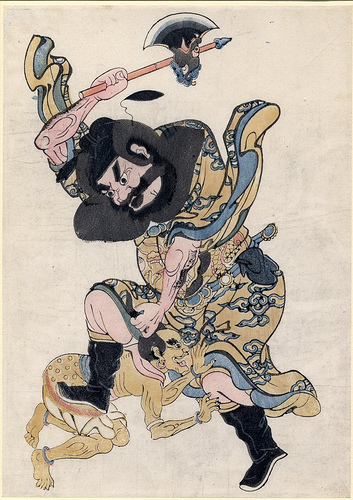
David Barista:We have only the glum knowledge that we help in our small multifarious ways to shape the universe, and endure a pervasive rumbling indifference and suspicion, descending to contempt. In a democratic society, the superstitious are courted by a political class that wears its populism like a mask. The philistines are celebrated for common sense and rationality while value is a matter of price. Power is won and lost by sloganeers.
a
a


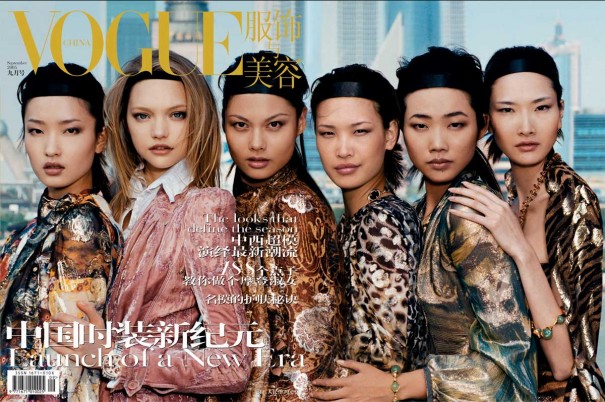



 COMMENTS
COMMENTS